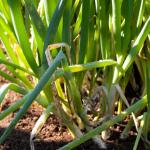Growing Spring onions, also Scallions, Bunching onions, Welsh onion
Allium fistulosum : Amaryllidaceae / the onion family
| Jan | Feb | Mar | Apr | May | Jun | Jul | Aug | Sep | Oct | Nov | Dec |
|---|---|---|---|---|---|---|---|---|---|---|---|
| S | |||||||||||
| P |
(Best months for growing Spring onions in USA - Zone 5a regions)
- S = Plant undercover in seed trays
- P = Sow seed
- Easy to grow. Sow in garden. Sow seed at a depth approximately three times the diameter of the seed. Best planted at soil temperatures between 50°F and 68°F.
- Space plants: Plant close together
- Harvest in 8-12 weeks.
- Compatible with (can grow beside): Lemon Balm, Borage, Carrots, Beets, Silverbeet, Lettuce, Amaranth
- Avoid growing close to: Peas, Beans
Can be grown from 'sets' (seedlings brought on earlier). Spring onions are grown close together and harvested before fully mature.
Do not like to be too dry. Best in a sheltered, sunny spot. If you are growing onions from seed, you can use the 'thinnings' as spring onions.
Culinary hints - cooking and eating Spring onions
Can be eaten raw in salads. Often used chopped and sprinkled on Asian stir-fry.


Your comments and tips